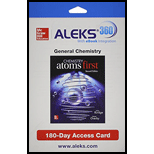
Use Le Châtelier’s principle to explain how the common ion effect affects the pH of a weak acid solution.
Interpretation:
By using Le Chatelier’s principle, the changes of pH of a weak acid solution due to common ion effect has to be explained.
Concept introduction:
- Le Chatelier's principle states that if a system in equilibrium gets disturbed due to modification of concentration, temperature, volume, and pressure, then it reset to counteract the effect of disturbance.
- When the concentration of one of the ions of a chemical solution got higher, it reacts with counter charged ions and precipitated out as salt till the ion product equals solubility product is called common ion effect.
- Incomplete dissociation of an acid in aqueous solution is called weak acid.
Answer to Problem 17.1QP
The pH of weak acid (acetic acid) increases due to addition of acetate ions from sodium acetate which suppress ionization of acetic acid leads to decrease in percent ionization of acetic acid. The equilibrium shifts towards left because of more acetate ion (common ion).
Explanation of Solution
To explain: The changes of pH of a weak acid solution due to common ion effect.
The equilibrium reaction of acetic acid and sodium acetate are as follows,
In an aqueous solution, dissolve acetic acid (weak acid) thoroughly which dissociates as acetate ions and hydronium ions. Then add sodium acetate (strong electrolyte) and it dissociates completely to form sodium ions and acetate ions. The common ion produced from both acetic acid and sodium acetate is acetate ion. By following the principle of Le Chatelier Principle, the acetate ions from sodium acetate combine with hydronium ions and the equilibrium shifts towards left which reduce the ionization of acetic acid. Thus lowers the percent dissociation of acetic acid and due to decrease in hydrogen ion concentration the pH of the solution will increase.
The change of pH of a weak acid solution due to common ion effect was explained by Le Chatelier's principle.
Want to see more full solutions like this?
Chapter 17 Solutions
Aleks 360 Access Card (1 Semester) For Chemistry: Atoms First
- Consider the titration of HF (K a=6.7104) with NaOH. What is the pH when a third of the acid has been neutralized?arrow_forward7. Describe a buffered solution. Give three examples of buffered solutions. For each of your examples, write equations and explain how the components of the buffered solution consume added strong acids or bases. Why is buffering of solutions in biological systems so important?arrow_forwardFor each of the following reactions, indicate the Brønsted-Lowry acids and bases. What are the conjugate acid/base pairs? (a) H3 O+(aq)+CN(aq)HCN(aq)+H2O (b) HNO2(aq)+OH(aq)NO2(aq)+H2O (c) HCHO2(aq)+H2OCHO2(aq)+H3 O+(aq)arrow_forward
- Write the Lewis structures of the reactants and product of each of the following equations, and identify the Lewis acid and the Lewis base in each: (a) CS2+SHHCS3 (b) BF3+FBF4 (c) I+SnI2SnI3 (d) Al(OH)3+OHAl(OH)4 (e) F+SO3SFO3arrow_forwardFor biological buffer systems, buffer acids capacity is usually greater than buffer bases capacity. Why?arrow_forwardHow does a buffer solution prevent larger change in pH? What does it mean when a solution has exceeded the buffer capacity?arrow_forward
- Chemistry: Matter and ChangeChemistryISBN:9780078746376Author:Dinah Zike, Laurel Dingrando, Nicholas Hainen, Cheryl WistromPublisher:Glencoe/McGraw-Hill School Pub Co
 Chemistry for Today: General, Organic, and Bioche...ChemistryISBN:9781305960060Author:Spencer L. Seager, Michael R. Slabaugh, Maren S. HansenPublisher:Cengage Learning
Chemistry for Today: General, Organic, and Bioche...ChemistryISBN:9781305960060Author:Spencer L. Seager, Michael R. Slabaugh, Maren S. HansenPublisher:Cengage Learning  Chemistry: The Molecular ScienceChemistryISBN:9781285199047Author:John W. Moore, Conrad L. StanitskiPublisher:Cengage Learning
Chemistry: The Molecular ScienceChemistryISBN:9781285199047Author:John W. Moore, Conrad L. StanitskiPublisher:Cengage Learning Introductory Chemistry: A FoundationChemistryISBN:9781337399425Author:Steven S. Zumdahl, Donald J. DeCostePublisher:Cengage Learning
Introductory Chemistry: A FoundationChemistryISBN:9781337399425Author:Steven S. Zumdahl, Donald J. DeCostePublisher:Cengage Learning Chemistry by OpenStax (2015-05-04)ChemistryISBN:9781938168390Author:Klaus Theopold, Richard H Langley, Paul Flowers, William R. Robinson, Mark BlaserPublisher:OpenStax
Chemistry by OpenStax (2015-05-04)ChemistryISBN:9781938168390Author:Klaus Theopold, Richard H Langley, Paul Flowers, William R. Robinson, Mark BlaserPublisher:OpenStax





